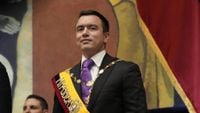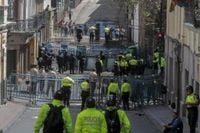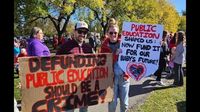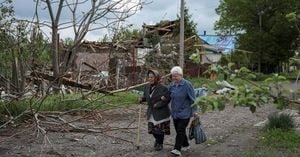Protests have erupted across Ecuador, gripping the nation in a tense standoff as President Daniel Noboa’s government faces mounting unrest over the abrupt removal of diesel fuel subsidies. For over two weeks, the country has been rocked by a national strike, with demonstrations, road blockages, and clashes between protesters and security forces spreading to at least half of Ecuador’s provinces. The government’s response—a sweeping state of emergency—has only deepened the divide, with both sides digging in amid escalating rhetoric and violence.
The spark for this crisis was the government’s decision to eliminate a long-standing diesel subsidy, which sent the price of fuel soaring from about $1.80 to $2.80 per gallon. According to UPI, the measure was framed by officials as a necessary fiscal adjustment to redirect funds toward social and productive programs. But the impact was immediate and severe, especially for rural communities, transportation workers, and Indigenous groups who rely on affordable fuel for their livelihoods. As one protester’s chant in Quito put it, “Diesel goes up, everything goes up.”
The Confederation of Indigenous Nationalities of Ecuador (CONAIE), the country’s largest Indigenous organization, quickly mobilized in response. The national strike, called by CONAIE, began on September 22, 2025, and has only grown in intensity. By October 5, the strike had entered its 14th day, with new groups—artists, university workers, and students—joining marches in the capital. According to the World Socialist Web Site, protesters in Quito were forced by police repression to seek refuge on the campus of the Central University of Ecuador but kept up their demonstration, chanting slogans and beating drums.
President Noboa’s government, facing mounting pressure, declared a state of emergency late on October 4, 2025, which took effect at midnight the next day across ten provinces with large Indigenous populations. This measure, as reported by K24 Digital, restricted freedom of assembly but stopped short of banning peaceful demonstrations outright. The president also ordered all branches of the Armed Forces and National Police to coordinate operations to maintain order, prevent violence, and guarantee free movement and economic activity.
Yet, the state of emergency has only fanned the flames of discontent. In a statement, CONAIE accused Noboa of “deepening his war policy” and unleashing systematic repression against those exercising their constitutional right to resist. Marlon Vargas, CONAIE’s president, warned that protests could escalate further or even “take over Quito” if the government failed to address their demands. “If we have to escalate, we will escalate the national strike; if we have to take the city of Quito, we will take it,” Vargas declared, according to UPI.
The government’s stance has been equally uncompromising. President Noboa, speaking on X (formerly Twitter), insisted he would not reverse the subsidy cut. “Those who choose violence will face the law. Those who act like criminals will be treated as criminals,” he stated. Minister of Government Zaida Rovira echoed the sentiment, telling reporters, “Ecuador has grown tired of violence.” Edgar Lama, president of the Social Security Board, dismissed the protesters as a minority seeking to impose their will through violence, saying, “There is nothing to discuss with a minority that seeks to impose its will through violence.”
The confrontation has not been without tragedy. Over the past two weeks, at least one protester has been killed and about 80 to 100 people detained, including 13 accused of terrorism. A week before the October 5 escalation, a violent clash between police and Indigenous protesters left one civilian dead and several injured. Some military personnel were also briefly held by demonstrators before being released.
Scenes of unrest have played out across the country. In Cotacachi, for instance, farms were surrounded at dawn by protesters from rural farming organizations who blocked employees from entering and forced workers under threat to join the strike. The National Association of Flower Producers and Exporters of Ecuador reported on X that these actions had paralyzed the flower industry, with ripple effects in the dairy and tourism sectors. The Chamber of Industries and Production estimated that, as of October 6, losses from the strike had already surpassed $70 million, mainly from lost sales and higher logistics costs.
Meanwhile, pro-government supporters have sought to project an image of unity and normalcy. In El Arbolito Park in Quito, ministers and officials attended an art fair under heavy police and military protection. But even these efforts have been overshadowed by the scale of the protests, which have now spread to at least 12 of Ecuador’s 24 provinces.
The political backdrop to the crisis is complex. Ecuador has been grappling with a severe security crisis since January 2024, when President Noboa declared an “internal armed conflict” in response to surging organized crime and violence. In September 2025 alone, the country recorded 6,210 incidents of violent crime, including robberies, extortion, and drug-related offenses, according to Xinhua. The government has extended the state of emergency in four coastal provinces and one canton for an additional 30 days, suspending constitutional protections against home searches and the privacy of correspondence.
While the government insists the fuel subsidy cut is essential for fiscal stability, its timing has proven incendiary. Many Ecuadorians recall similar unrest in 2022, when then-President Guillermo Lasso’s attempt to end the diesel subsidy led to 18 days of violent protests, eight deaths, and more than 600 injuries. Unlike his predecessor, Noboa appears more secure in office and has responded swiftly with decrees and forceful rhetoric, but the fundamental grievances remain unresolved.
CONAIE and other protest leaders have called for “real responses to the people’s demands” instead of further states of emergency. Their message is clear: the country’s poorest and most vulnerable communities cannot bear the brunt of austerity measures. The government, for its part, has shown little willingness to compromise, arguing that order and economic reform must take precedence.
As talks between the government and Indigenous groups remain stalled, the situation appears poised for further escalation. Roadblocks, strikes, and clashes continue, with both sides accusing the other of intransigence and violence. The outcome of this standoff will not only shape Ecuador’s immediate future but also serve as a test of how the country balances fiscal necessity with social justice and democratic rights.
For now, Ecuador remains in a state of suspended tension—its streets filled with the sounds of protest, its government standing firm, and its people waiting to see who will blink first.






